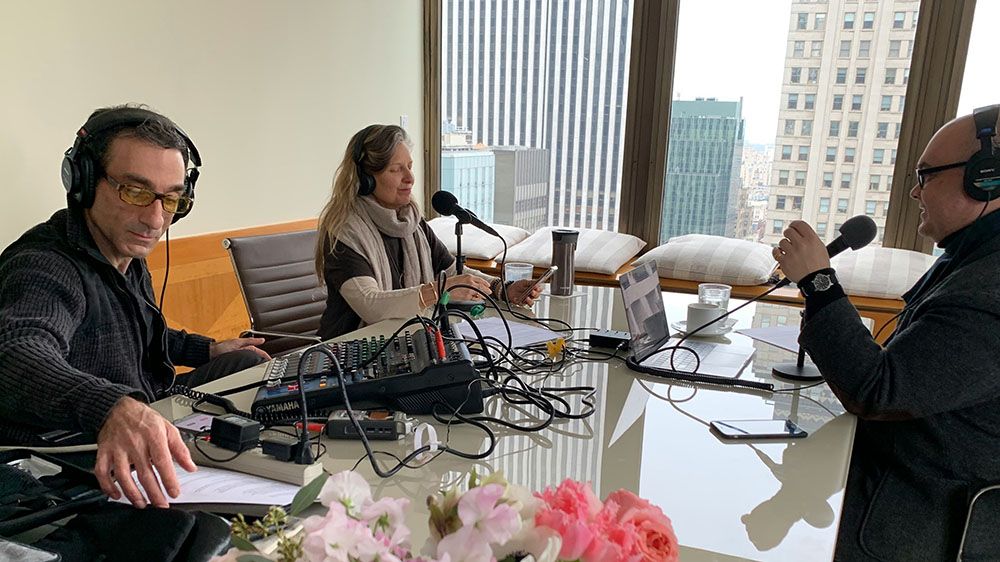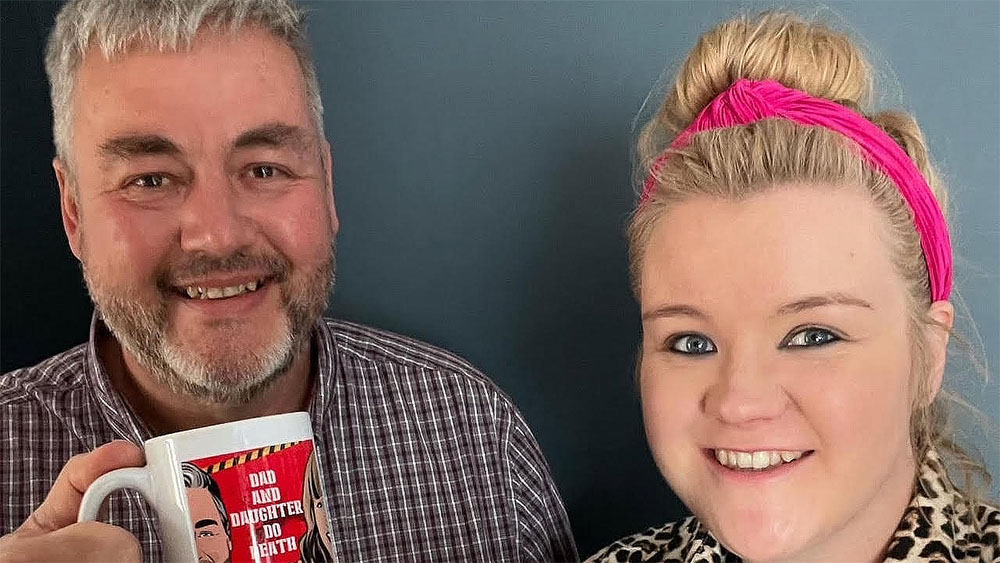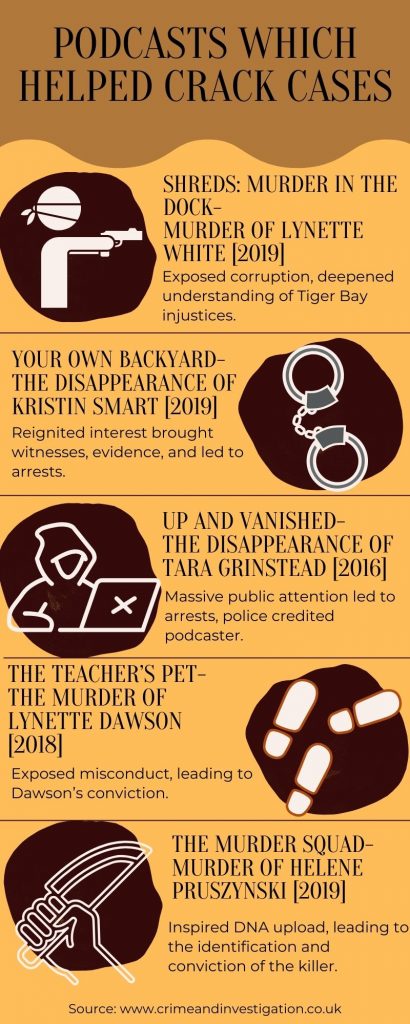Why does true crime dominate the podcast charts, and what goes into creating a compelling series that captivates audiences?

In a quiet English village, a body is found on the edge of a canal. Police never found out what happened. Years later, the details come back to light, but not in court or a newspaper, instead through a voice narrating the story in Rita’s headphones on her commute to work.
The same questions that were asked a couple of decades ago are still being asked. Who was to blame, what really happened, and can the truth be found now?
“It’s like reading a thriller, but it hits harder because it’s real,” says Rita, a 26-year-old from Birmingham. For her, the pull of true crime is its blend of suspense and reality. “The podcasts turn these cases into stories you can actually follow, and they’re so easy to listen to. I’ve usually got one on, whether I’m cooking, walking, or commuting.”
This is what makes the true crime podcast so appealing. Millions of people can hear stories that were once hidden in archives or left in files that were half-forgotten. They are told again with forensic details and a dramatic pace. Podcasts like They Walk Among Us, RedHanded, and Uncanny often top the charts in the United Kingdom, while international shows like Serial, Rotten Mango and Casefile draw huge audiences in the UK.
Ofcom reports that nearly a quarter of UK adults now listen to podcasts every week, with crime consistently being one of the most popular categories.

Adam Lyod, host of the UK True Crime podcast, says crime has long captured public attention. “True crime isn’t just entertainment. It’s relatable because it reminds us of life’s unpredictability. Crime is part of everyday life. People have always been fascinated by it, from Victorian newspapers to modern TV. The internet amplified this interest, allowing people to explore cases in depth,” says Adam.
True crime podcasts have driven public interest in cold cases, sometimes prompting police to reopen lines of inquiry. They have also created communities of amateur sleuths, trading theories online and fueling demand for more episodes.
One of the most well-known instances occurred in the US when Serial prompted fresh court challenges in Adnan Syed’s murder case. The impact has been less noticeable but no less noteworthy in the UK. The National Podcast Award-winning show, They Walk Among Us, has revisited cases from decades ago, attracting listeners who frequently post new information on social media. In certain cases, victims’ families have reached out to producers directly in an attempt to restore long-lost files to the public domain.
The question for podcast makers is how to keep that momentum alive, how to craft narratives that entertain and captivate.
Why is true crime popular?
Listeners continue to engage with stories of unsolved murders, missing people, and criminal trials in part because true crime podcasts use established storytelling techniques such as mystery, suspense, and the presentation of evidence within a format that delivers information directly and sequentially to the audience.
Dr. Sharon Packer, a psychiatrist in private practice and Assistant Clinical Professor of Psychiatry & Behavioural Sciences at the Icahn School of Medicine at Mount Sinai, offers insight into why audiences are drawn to true crime to the Decider.
It could be like a dress rehearsal. Like the old-fashioned fire drills or air raid drills, they had to keep practising in case a devastating event happened, and they expected it to happen. I think there’s a certain degree for that.
says Dr. Sharon
Dr. Packer’s idea of rehearsal is only part of the explanation for why audiences are drawn to true crime. For starters, she points to schadenfreude. She says, “It’s basically a fancy German word that was used by Freud and the psychoanalysts back when they spoke German, about people getting pleasure in other people’s problems and other people’s suffering.”
She says that, when misfortune strikes, listeners can experience a sense of relief knowing it happened to someone else rather than themselves. She says, “It’s vicarious. It’s not necessarily sadistic, but if bad fate had to fall on someone, at least it fell on someone else.”
Dean Fido, Lecturer in Psychology at the University of Derby Online Learning, thinks it is all about the puzzle presented. In the Derby Magazine, he says, “True crime is very different from the typical shows you normally have on in the background. They are the sort of stories you need to put your phone down and actually pay attention to. It’s a big puzzle, and we don’t want to be left without a vital piece of information because we were checking social media.”
Podcast makers agree. Mark Randell, co-host of the Seeing Red podcast, says part of the appeal of true crime lies in its relatability. He says, “Ordinary, relatable stories grasp attention because people can think, ‘This could happen to me or someone I know.’ That fear and relatability engage the audience. It’s the thrill of fear in a safe environment, similar to a roller coaster. Entertainment doesn’t mean frivolous enjoyment. It can be educational and thought-provoking.”

Phoebe Broad and Philip Drinkwater, a father-and-daughter duo behind the podcast Dad and Daughter Do Death, view the appeal of true crime as a reflection of human curiosity. Philip says, “We see true crime interest as a reflection of human curiosity about death, human behaviour, and morality. True crime appeals because it examines human behaviour.”
There is also the simple fact of portability. True crime podcasts fit into everyday life, whether on the train, at the gym, or in the kitchen. The podcasts turn those times into parts of a bigger mystery. Ofcom data shows that younger listeners use podcasts as background chatter, but the genre’s hold is strongest when the story is structured like a puzzle to be solved.
There is also the question of timing. True crime podcasts emerged during a period of heightened interest in long-form storytelling, driven by streaming series and binge culture. Listeners who once devoured box sets now consume multi-part investigations on their commute or during daily routines. The cliffhanger endings, familiar to television, have translated perfectly into episodic audio.
Critically, the stories extend beyond entertainment. For some, following a case is about the pursuit of justice, however delayed. The idea that a podcast could uncover new information or push authorities to revisit an investigation gives the genre an added charge. In that sense, true crime podcasts satisfy both narrative curiosity and a public appetite for resolution.

Building a podcast that hooks listeners
Behind every successful true crime podcast is careful construction. Listeners may feel as if they are simply being told a story, but the pacing, tone and structure are the result of hours of planning.
According to Adam, the host of a UK true crime podcast, the work behind the scenes is often underestimated. He says, “People think it’s easy, like just reading Wikipedia entries. In reality, research and preparation take 15-18 hours per week. Accuracy and nuance are critical.”
According to producers, selecting a case is frequently the first important decision. While some shows purposefully select obscure or underreported crimes, others concentrate on murders that make headlines.
Adam, with nine years of podcasting experience, says that he avoids typical domestic abuse cases because they are common and often lack nuance. He says, “I look for depth, context, and human stories people can relate to. The case has to interest me first. If I’m not engaged, I can’t produce an effective narrative. It’s about creating empathy for the people involved.”

Mark says audience suggestions often guide their choices. He says that research for each episode involves consulting 10–15 publicly available sources, including sentencing remarks, newspapers, and sometimes books.
Phoebe and Philip describe a similar approach. Phoebe says, “We focus on older cases and historical context, often with an element of mystery. We choose cases carefully. We prefer cases that allow exploration of human behaviour.”
Our motivation is sharing stories, keeping historical true crime alive, and providing perspectives for listeners.
says Philip
Phillip says their goal is to preserve historical true crime. He says, “Our motivation is sharing stories, keeping historical true crime alive, and providing perspectives for listeners. We emphasise that research, reputable sources, and ethical boundaries are key.”
Once a case is selected, the challenge is how to present it. Simple chronological retelling is rarely used in successful podcasts. Rather, they create suspense through well-placed cliffhangers, interviews that reveal new details gradually, and narration that leads the audience through a complex web of facts. This method is as much a product of documentary and drama traditions as it is of journalism.
According to Adam, making the people involved feel real is central to engagement. He says, “The main goal is to make the people real. In my podcast, I try to convey a person’s life. What music they liked, what they did on a quiet Sunday, even small details. Making the person relatable helps the audience connect and ensures the story feels authentic.”
Phoebe emphasises the importance of storytelling craft. She says, “Good storytelling is key. Things like structure, clarity, and engaging narration matter.”
Another important component is sound design. In order to establish mood, atmospherics and music are used sparingly but effectively. Many listeners find that these details are what make an episode captivating enough to keep their interest late at night in bed or on a packed train.
Adam says that episode length and consistency also play a role in audience engagement. He says, “I keep my episodes around 30 minutes. It suits the average commute and people’s attention span. I value consistency over length. Producing a two-hour episode weekly isn’t realistic. Short, consistent episodes build trust with the audience.”

The real development of a podcast occurs during editing. According to podcasters like Adam and Mark, distilling hours of research and interviews into a carefully planned storyline that releases information at precisely the right time is an essential step. In addition to narrating events, the aim is to create an ongoing investigation that keeps the listener guessing about what will happen next.
True crime podcasts have risen above background listening and become appointment audio for millions of people thanks to their unique blend of journalism, storytelling craft, and technical precision.
In addition to being entertaining, true crime podcasts have occasionally altered the direction of actual investigations. Podcasters can bring attention to cases that might otherwise be lost in police archives by re-examining unsolved crimes.
Phoebe acknowledges this potential impact but emphasises the primary focus. She says, “Podcasts can sometimes assist real cases, but the primary motivation is storytelling, not entertainment or profit.”
The distinction between public service and storytelling is now blurred by true crime podcasts. In addition to providing entertainment, they can serve as a catalyst, reminding viewers and occasionally law enforcement that a case is never fully solved until the answers are discovered.
Mark, the co-host of the Seeing Red podcast, says the importance of motivation in this work. “Ask yourself why you’re doing it. It must be for the right reasons, to honour victims, support charities, and educate the audience, not for money or fame. Passion and ethics are critical,” says Mark.
Craft is just as much of a challenge for podcasters as content. The most effective shows are methodically constructed, suspensefully layered, led by a steady voice, and release information in a methodical manner. The combination of intimacy and suspense, as well as the sense of being invited behind the scenes of an unsolved mystery, is what draws viewers in.
The broader significance is cultural. The listeners of these podcasts are as eager to solve mysteries as they are to see justice done, reflecting a society that seeks both entertainment and accountability. In that sense, the story never truly ends.
For audiences like Rita, the appeal of true crime extends beyond the story itself. She says, “It feels personal and not just entertainment. It’s a window into how society deals with crime, justice, and human behaviour.”